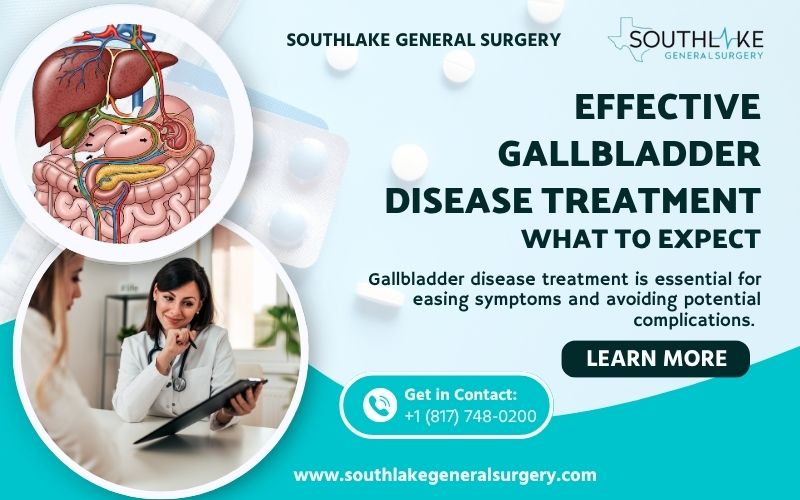Gallbladder disease treatment is essential for easing symptoms and avoiding potential complications. The gallbladder, located beneath the liver, acts as a storage space for bile, which is crucial for digestion.
Disruptions—such as inflammation, infection, or gallstones—can cause discomfort and health risks. Understanding treatment options is vital for affected individuals, who may start with lifestyle changes to reduce risk factors.
Key Highlights
- Gallbladder disease includes several issues that impact the gallbladder and bile ducts. This can happen due to inflammation, infection, or gallstones.
- Common symptoms include nausea, vomiting, and/or abdominal pain; in rare cases, jaundice and fever may also be present. These signs may need quick medical help.
- Doctors use different ways to diagnose gallbladder problems. These consist of blood tests and sophisticated imaging procedures like endoscopic ultrasound and HIDA scan.
- Treatment usually involves changing habits, getting prescriptions for medication, and in serious cases, gallbladder removal surgery, known as laparoscopic cholecystectomy.
- To avoid gallbladder disease, it is good to eat healthy, exercise often, and manage risk factors like obesity and high cholesterol.
- Dr. Valeria Simone, MD, at Southlake General Surgery, provides expert diagnosis and tailored care plans to help manage gallbladder disease well.
Understanding Gallbladder Disease
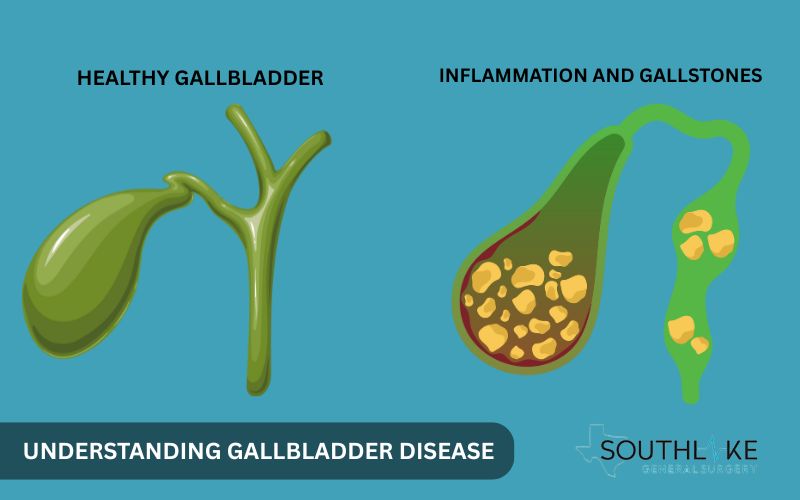
Gallbladder disease happens when there are problems with how the gallbladder works. Even though it is compact, the gallbladder plays a crucial role in the overall operation of the body. It helps move bile, which is needed for digestion and good health. Problems often begin in the gallbladder or in the nearby bile ducts. If these issues are not fixed, they can impact other parts of the digestive system.
Gallstones or slow bile release can make your belly swell. This can lead to ongoing pain or a troubled stomach. Fortunately, getting quick treatment can manage most gallbladder issues well.
Definition and Overview of Gallbladder Disease
A wide variety of conditions affecting the gallbladder are together known as gallbladder disease. A tiny sac called the gallbladder sits beneath the liver. It holds bile, an essential element for digestion. The small intestine’s fat digestion is greatly facilitated by the passage of bile through its ducts. Blockages, infections, or issues in these ducts can lead to inflammation. This inflammation can prevent bile from flowing correctly, leading to various disorders.
Gallstones can cause gallbladder disease. They form when there is too much cholesterol or other substances that create small lumps. Some people feel no symptoms, but others may feel pain and swelling when the gallstones block the bile ducts. There may also be long-term issues, like biliary dyskinesia. This may hinder the proper flow of bile. As a result, it can lead to constant inflammation.
When bile collects in the body, bad substances that should leave can get back into the blood. This can hurt digestion and the liver. It’s important to find and fix these issues fast. Doing this helps avoid complications and keeps digestion working well.
Types of Gallbladder Conditions and Their Severity
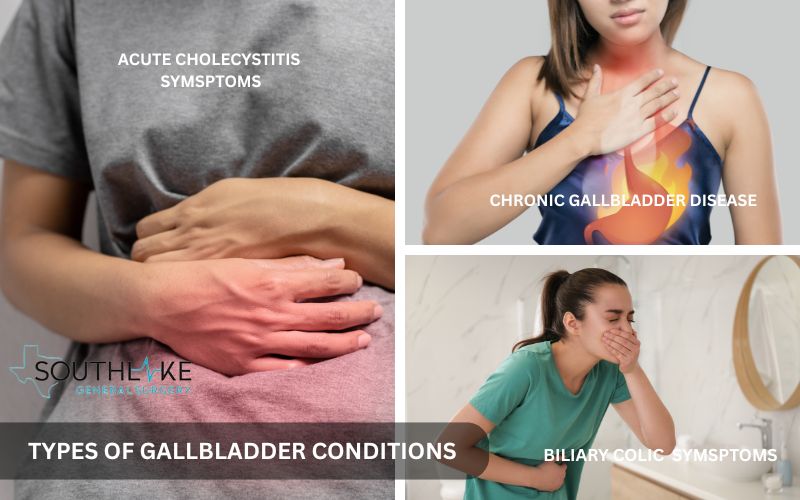
Gallbladder problems can be mild or more serious. Here are some common gallbladder conditions and their seriousness:
Acute cholecystitis: This condition arises when the gallbladder suddenly becomes inflamed. This swelling often happens when gallstones block the flow of bile. Common signs include:
- Fever
- Nausea
- Severe pain in the upper abdomen
This needs urgent medical care.
Chronic gallbladder disease: This develops slowly over time. It can cause scarring or stiffness in the gallbladder tissues. Symptoms may include:
- Bloating
- Mild indigestion
Even though these seem minor, ignoring them can make things worse and affect digestion.
Biliary colic: This leads to pain that comes and goes due to a temporary blockage in the bile. While it may feel mild, frequent pain can indicate bigger issues. A quick check at Southlake General Surgery can help identify the cause before serious problems, like:
- Gangrene
- Bile duct tears occur.
What are the five key factors associated with gallbladder disease?
The memory tool named “Five Fs” includes fair, female, fat, fertile, and forty. It helps us find demographics and risk factors linked to gallbladder disease. Although this idea is not new, its points about obesity, gender, age, and other influences are still important today.
- Fair: White people are more likely to have gallbladder disease. This may happen because of their genes or diet.
- Female: Women are at double the risk. This is due to hormones like estrogen during pregnancy and at other times.
- Fat: Carrying extra weight can lead to cholesterol building up in the bile. This raises the risk of gallstones.
- Fertile: During pregnancy, hormones may slow down how the gallbladder empties. This may result in the formation of gallstones or cause inflammation.
- Forty: As people age, the risk of gallbladder issues goes up. This happens because bile can hold more unprocessed material over time.
These points show trends. However, they oversimplify our existing understanding. Genetics, diet, and lifestyle all play a role in the risk of gallbladder problems for different people.
Symptoms of Gallbladder Disease
Gallbladder disease symptoms can be different for each person. Sometimes, they feel mild, while at other times, the signs can be severe, needing quick medical attention. Common early signs consist of discomfort in the abdominal area, sensations of queasiness, and instances of vomiting.
You usually feel these around your upper right rib cage or just below your right shoulder. If the symptoms get worse, you could have a fever, jaundice (a yellowing of the skin), or dark urine. These signs might mean there is too much bile in your bloodstream.
If your symptoms continue or get worse, it’s recommended to seek medical advice. A specialist like Dr. Valeria Simone, MD, can give you an exam and make a plan just for you.
Common Signs to Watch For Gallbladder Conditions
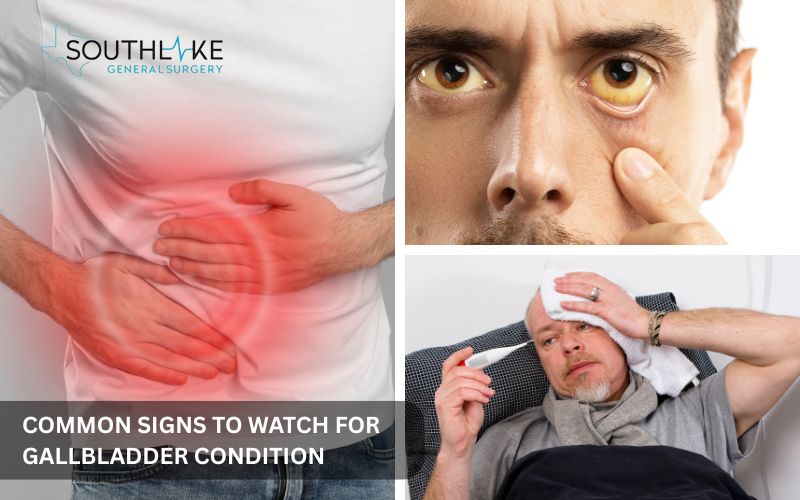
Gallbladder problems frequently begin with a type of pain known as biliary colic. A sharp ache is felt in the upper right quadrant of the abdomen. It usually worsens after eating since the gallbladder releases the bile. You may also feel:
- Nausea
- Vomiting during these times
In serious cases, gallbladder inflammation can cause intense and long-lasting pain. You may feel:
- Fever
- Chills
- Jaundice
- Dark urine
- Pale stools
These signs indicate that the flow of bile may be deteriorating. If you experience these symptoms, it’s a good idea to consult a doctor right away. It’s important to check for serious issues like a ruptured gallbladder or infections like peritonitis.
Less severe, ongoing symptoms can include:
- Bloating
- Indigestion
- Diarrhea
These symptoms might hide how serious the problem is. Recognizing these indicators promptly is essential. Consult with Southlake General Surgery to effectively address your symptoms and safeguard your well-being.
When to Seek Medical Attention
Some signs of gallbladder issues need quick attention. If you see:
- If you have strong stomach pain that lasts several hours or gets worse, it could mean there is a blockage in the bile ducts or gallstones.
- If you’re experiencing nausea, vomiting, or a fever, it’s important to seek immediate medical attention at the emergency room.
Noticing visible signs like:
The medical condition known as jaundice causes the skin and eyes to turn yellow. It can also cause your urine to be dark or your stools to be light in color. These signs are important to take seriously.
These indications might suggest that bile is accumulating in your bloodstream. It’s important to obtain tests promptly, such as imaging, at Southlake General Surgery.
Don’t overlook common signs such as mild stomach pain. If you leave these small issues untreated, they can turn into serious problems. This could result in scarring or gangrene within the gallbladder. It’s important to seek care on time and keep up with check-ups to prevent emergencies.
Diagnostic Approaches for Gallbladder Disease Treatment
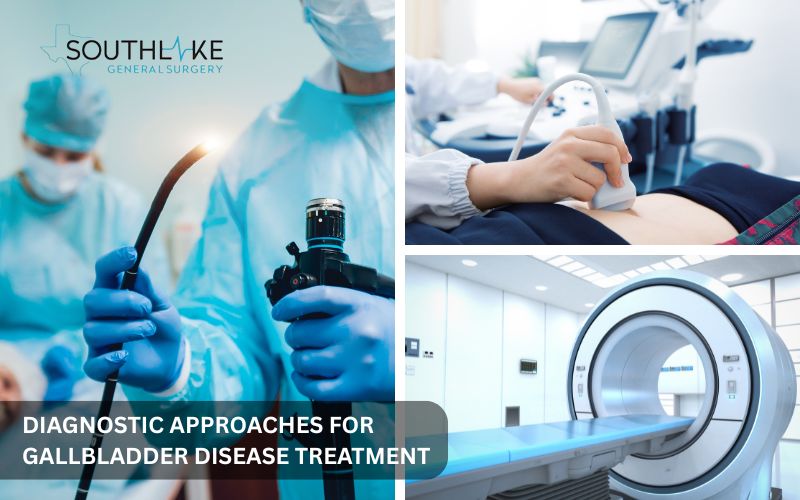
To check for gallbladder disease, you need to review your medical history and note your symptoms. Dr. Valeria Simone will conduct blood tests to identify any infections or inflammation. She will also perform physical examinations to assess the condition of your gallbladder.
Advanced tests such as abdominal ultrasound, HIDA scans, and endoscopic ultrasound provide real-time details about blockages in the bile ducts or if there are gallstones. Each test checks the seriousness of your condition. This assists healthcare professionals in selecting the most effective treatment for your healing process.
Initial Assessments and Tests Recommended by Dr. Simone
At Southlake General Surgery, Dr. Simone takes time for detailed first checks to find any problems with the gallbladder. These first checks include:
- Have regular blood tests to check white blood cell counts. This helps spot signs of infection or inflammation.
- Examine the liver and pancreas to identify any potential problems with bile flow.
Dr. Simone performs physical exams to review the information from blood tests. This helps her to:
- Examine the abdominal region for any indications of pain related to the gallbladder.
- Monitor for any signs of discomfort or swelling in the region around the rib cage. This may suggest initial signs of inflammation or injury to the tissue.
Additionally, imaging methods, such as:
- Abdominal ultrasound
- HIDA scans
Dr. Simone checks how well the gallbladder is working. She looks for signs of blockages or slow bile movement. This careful way of diagnosing helps her provide quick and clear care for each patient.
Advanced Diagnostic Techniques for Gallbladder Diagnosis
For difficult cases, Dr. Simone uses some special tools, including:
- Endoscopic Ultrasound (EUS): This tool provides clear images of the bile ducts, gallbladder, and liver by using sound waves. It works without any surgery.
- Magnetic Resonance Cholangiopancreatography (MRCP): This method uses magnetic fields to view the ducts linked to gallbladder disease.
In tough situations, Endoscopic Retrograde Cholangiopancreatography (ERCP) is used. It includes:
- A camera endoscope and fluoroscopy X-rays are used to capture images.
- During the procedure, we can also fix problems at the same time. This includes checking the flow of bile, removing stones, placing stents in ducts, or taking biopsies—all in one session.
This advanced equipment ensures that patients receive the correct diagnosis. It helps speed up recovery by quickly detecting and treating blockages or gallstones during the exam. This leads to the best possible results for patients.
Management and Treatment
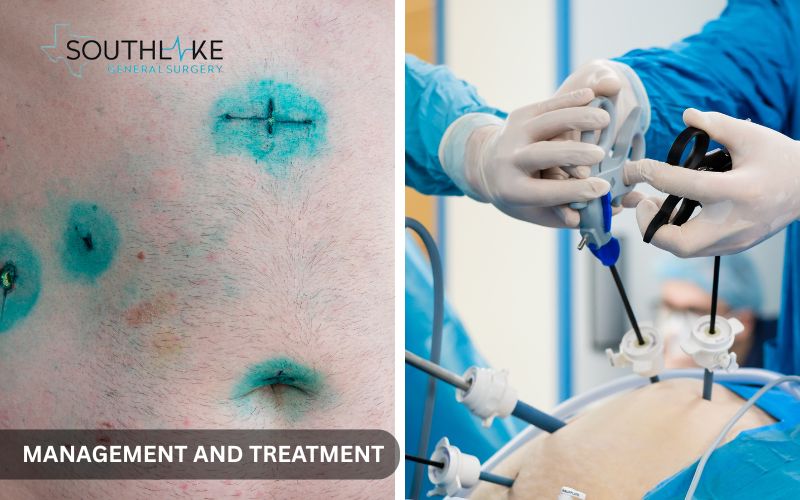
The optimal approach to managing gallbladder disease varies based on its classification and severity. For mild issues, like biliary colic, doctors may give medicines. They may prescribe antibiotics if there is an infection. At Southlake General Surgery, Dr. Valeria Simone creates tailored treatment plans. These plans focus on relieving pain and suggesting healthier eating habits.
For serious cases, they use careful ways like laparoscopic cholecystectomy to remove the gallbladder. This method helps you heal faster. Dr. Simone customizes her treatments to safeguard your digestive well-being and minimize risks and pain throughout the procedures.
How is gallbladder disease treated?
The main approach for addressing gallbladder disease is through surgical intervention. A common type of surgery is gallbladder removal, which is also called laparoscopic cholecystectomy. Dr. Simone often does gallbladder removal surgery. This method uses special surgical tools and a tiny video camera. This makes the surgery less invasive. It only needs small incisions.
Before the surgery, doctors give antibiotics to prevent infections. They might also use endoscopic techniques like ERCP. These techniques can help remove stones or clear ducts. This can make recovery easier later.
Making changes to your lifestyle can lower risks. But when there is a lot of inflammation, infection, or ongoing damage, surgery may be needed. Southlake General Surgery works to perform careful procedures that make sure you feel comfortable.
Prevention
To avoid gallbladder disease, increasing your fiber intake is essential. You should also cut down on cholesterol and drink lots of water. Consistent physical activity benefits digestion and aids in the movement of bile. Don’t forget to schedule your routine health check-ups, too.
Managing risk factors like obesity and hormone problems is important for your gallbladder health. Talking with experts such as Dr. Simone at Southlake General Surgery is prepared to help you develop a customized plan to reduce your specific risks.
What can I do to prevent gallbladder disease?
Optimizing your diet can really help with gallbladder problems. Here are some good tips:
- Add plants and whole grains to your meals. This promotes the smooth flow of bile and reduces cholesterol levels within the ducts.
- Limit fatty processed foods. These foods are frequently associated with the development of stones.
Daily exercise is important to keep bile flow on track. This helps your digestive health. Engaging in regular activity allows you to:
- Reduce the chances of blockages in the ducts.
- Lower the risk of inflammation in different organs.
Lastly, we should pay attention to risk factors like obesity and hormonal changes. This practice can help prevent gallbladder disease, especially in those who are at higher risk. You can enhance your health by making lifestyle changes. For this, you can seek support from Southlake General Surgery and Dr. Simone.
Conclusion
To handle gallbladder disease well, you should know the symptoms, how doctors diagnose it, and what treatments are available. The treatment plan can change based on the issue. For example, it can differ if you have acute cholecystitis or chronic gallbladder disease.
In some cases, surgery may be necessary. A common method is laparoscopic cholecystectomy, especially if there is gallbladder inflammation or blockage. Using modern tools like endoscopic ultrasound and MRI can assist in diagnosing and managing these problems more effectively.
Taking preventive actions can help you stay healthy. Eating a good diet that has little cholesterol, and sugar can greatly lower the risk of gallstones and other problems. Keeping track of your gallbladder health can help you make good choices. It is essential to be active about your health. It is important to get medical advice if you encounter any symptoms. Empower your digestive health starting now.
Make an Appointment
Scheduling an appointment with Dr. Valeria Simone at Southlake General Surgery is a good first step to deal with gallbladder disease. To make an appointment, just call her office at +1 (817) 748-0200.
During your visit, Dr. Simone will go over your medical history. She may suggest tests like an abdominal ultrasound or a HIDA scan. These tests will assist in identifying any inflammation or obstruction in the bile ducts.
Dr. Simone is experienced in laparoscopic cholecystectomy and treating acute cholecystitis. She will help you understand the recovery steps you need to take.
Frequently Asked Questions
What are the first steps in treating gallbladder disease at Southlake General Surgery?
Dr. Simone starts with a consultation. She checks your medical history and does tests like blood tests and an abdominal ultrasound. These steps help her see how serious your gallbladder issues are. This way, she can create a good treatment plan for you.
Medically Reviewed By: Dr. Valeria Simone MD
Board-certified General Surgeon at Southlake General Surgery, Texas, USA.
Follow us on Facebook and YouTube.
References:
- Jones, M. W., Kashyap, S., & Ferguson, T. (2022, September 19). Gallbladder Imaging. StatPearls – NCBI Bookshelf. https://www.ncbi.nlm.nih.gov/books/NBK470366/
- Diagnosis of gallstones. (2025, February 21). National Institute of Diabetes and Digestive and Kidney Diseases. https://www.niddk.nih.gov/health-information/digestive-diseases/gallstones/diagnosis
- Saiman, Y. (2023, August 4). Overview of biliary function. Merck Manual Professional Edition. https://www.merckmanuals.com/professional/hepatic-and-biliary-disorders/gallbladder-and-bile-duct-disorders/overview-of-biliary-function
- Quoraishi S, Ahmed J, Ponsford A, Rasheed A. Lessons learnt from a case of extracorporeal shockwave lithotripsy for a residual gallbladder stone. Int J Surg Case Rep. 2017;32:43-46. doi: 10.1016/j.ijscr.2017.02.001. Epub 2017 Feb 3. PMID: 28235649; PMCID: PMC5322175.

